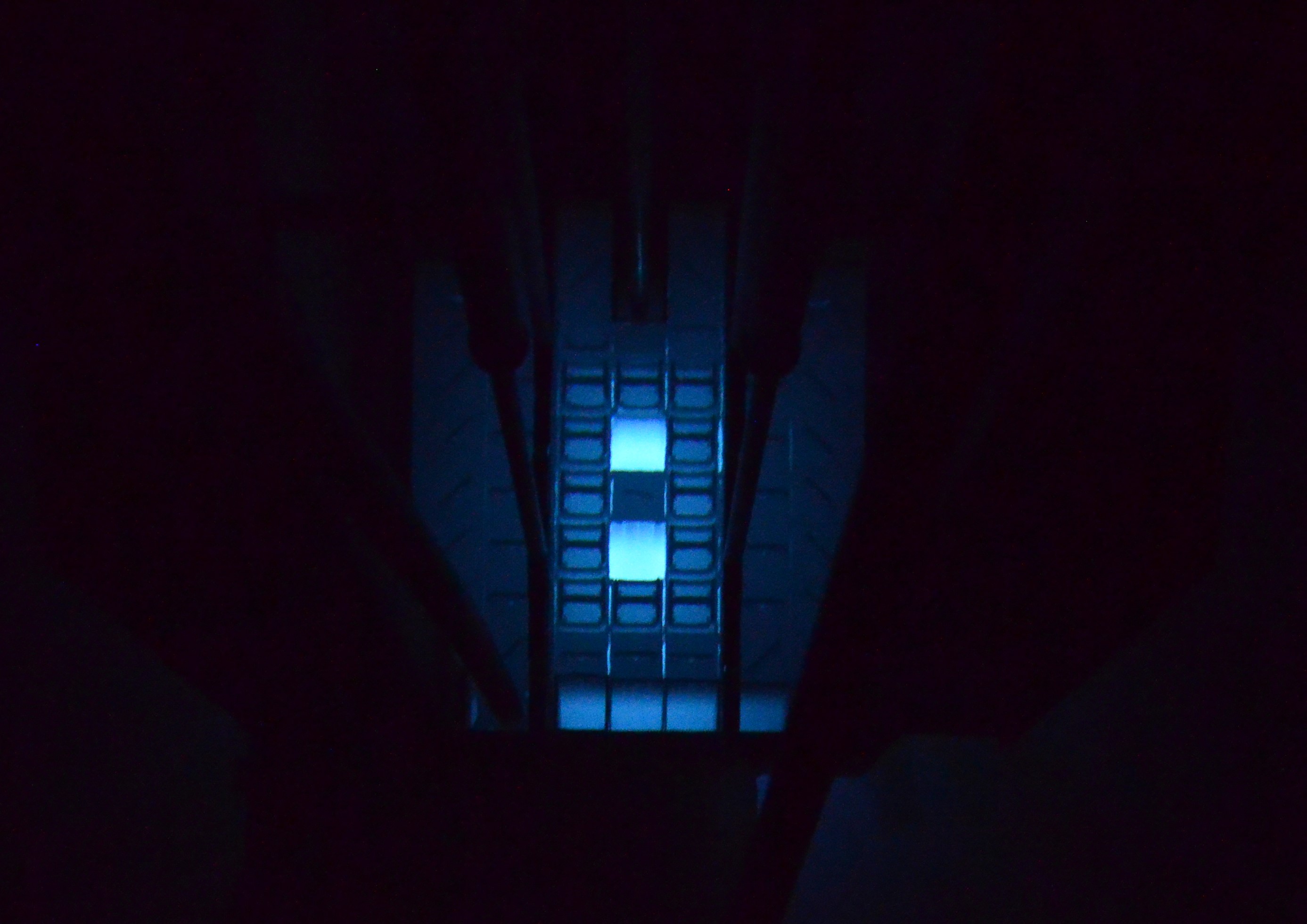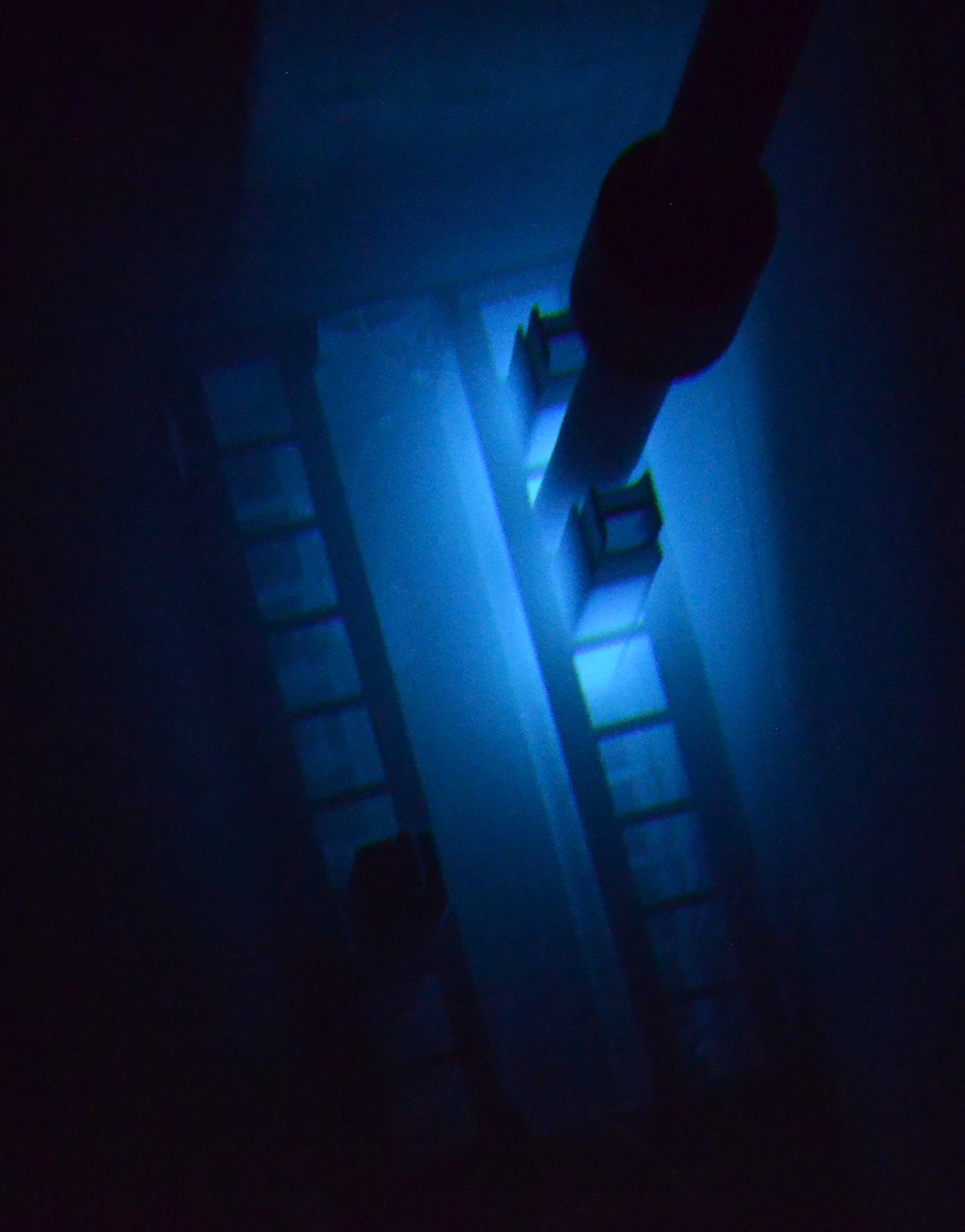

State of Rhode Island: Nuclear Science Center
Skip to content | Skip to navigation | Skip to other related content
Experimental Facilities:
Beam Ports:
- Large pipes that run from the experimental floor to the reactor core
- Maximum neutron flux of 3x1012 n/cm2s at core end, and minimum neutron flux is 5x107 n/cm2s at the flange end 6 inch and 8 inch ports available
- Allows for a maximum sample size of 7.75” diameter and 3’ length
- Small wires can reach the sample, allowing for small probes to take real-time measurements at the sample location
- Irradiation time can be on the order of days with approval
- Samples need to be loaded before reactor start-up and can only be removed 4.5 hours after reactor shut-down

Rabbit System:
- Pneumatic system allowing samples to travel next to the core while user waits in a lab setting
- Neutron flux of 2x1012 n/cm2s
- Samples can be placed in “bunnies” or “rabbits”
- “Bunnies” allow a maximum samples size of 1.125” dia. x 3.5” length
- “Rabbits” allow a maximum sample size of 1.125” dia. x 6.25” length
- Maximum single irradiation time of 2 hours before the “rabbit” or “bunny” needs to be changed
- Samples return to the user immediately after irradiation time to be stored in a lead cave under the system or analyzed immediately
InCore Tube:
- Samples are placed into a tube and lowered into an empty basket slot next to the fuel elements
- Maximum neutron flux of 1.8x1013 n/cm2s
- The area in the tube were the maximum flux occurs is about 9” tall
- Maximum sample diameter to fit into the tube is 1.25”
- Maximum height of sample for maximum flux is 9”
- Samples need to be loaded before a start-up and can be removed only after the reactor has shut-down
- Sample irradiation time can be on the order of days with approval

CapStone Beam Port:
- Device located at the opening of a 6” un-shielded beam port that allows sample changes while the reactor is in operation
- Maximum neutron flux of 4x107 n/cm2s
- Sample cart allows for a maximum sample size of 7”L x 5”W x 3”H
Thermal Column:
- Large experimental facility that blocks almost all fast neutrons, allowing for a pure thermal neutron flux
- Samples are placed within a graphite grid and can be 1.5” in diameter
- Maximum thermal neutron flux of 1.2x109 n/cm2s

Gamma Tube:
- Gamma irradiations are conducted for the purpose of sterilization of samples and/or to study the effects of gamma irradiation on materials.
- Large experimental facility that blocks almost all fast neutrons, allowing for a pure thermal neutron flux
- The Gamma Tube (GT) is a 3-inch ID aluminum pipe, held vertically against the north wall of the low power section of the pool. The Gamma Tube is a dry experimental area.

Research Assistance:
Gamma Spectroscopy System:
- RINSC has multiple Gamma spectroscopy systems available to analyze activated samples from the reactor facilities
- Sample changers are available to count a large amount of samples without the need for a lab technician
Sample Heater:
- High temperature heater located at the Flange-end of a 6” beam port
- Maximum temperature of 1800° C
- Maximum sample diameter of 1”
- Maximum neutron flux of 4x108 n/cm2s
Survey Equipment:
- Multiple exposure, dose, and cpm measuring instruments
- LSC and Wipe counter to check for contaminated samples and work areas
Other:
- Multiple shielding materials and PPE
- Lab space
- Meter calibration check services
- Multiple qualified reactor operators and health physics personnel to ensure safety in radioactive experiments and guidance for projects
- DOT shipping certified personnel
- Expansive radioactive materials license
Neutron Activation and Gamma Spectroscopy:
The RINSC has multiple methods for irradiating samples for Neutron Activation Analysis. Small samples can be put in “rabbits” and transported directly to the core using our 2 pneumatic rabbit systems. For larger samples the sample can be loaded into a basket and placed directly adjacent to the core before the reactor is started. Even larger samples can be placed inside our thermal neutron room located on the reactor floor.
For analysis of activated samples the RINSC has a High-Purity-Germanium gamma-spectroscopy detector available. The detector is used to identify and quantify radioactive isotopes present in solid, liquid, or gaseous samples.
Neutron Diffraction:
The powder-diffractometer is used primarily for undergraduate instruction. It employs a mica monochromator and a custom collimator. The powder diffractometer has an angular resolution better than 1 arc min. The instrument is controlled by a local computer running software developed in house.
The other diffraction instrument is a Small Angle Neutron Scattering (SANS) instrument. It employs a 2-dimensional position sensitive gas (3He) detector. This allows users to see a 2 dimensional histogram of the diffraction pattern. The detector and its shielding can be moved allowing a wide range of angles and orientations to be achieved. It is controlled using software developed at Oak Ridge National Lab's
Spallation Neutron Source. Data analysis software was
developed in house and is available to researchers by request.
Other Irradation:
In addition to the reactor, the RINSC has an instrument calibration range that is equipped with a 40 Ci Cs-137 source, as well as a variety of smaller radiation sources. These sources are not only useful for instrument calibrations, but also for low level gamma irradiation of samples.
Current Research Projects:
Detector Research for Brown University

The High Granularity Calorimeter (HGCAL) planned for the upgraded Compact Muon Solenoid (CMS) detector will be subjected to a large radiation dose during several years of exposure to 14 TeV center-of-mass proton-proton collisions. Different types of sensors are being studied and optimized for the expected radiation dose. Important information regarding radiation tolerance and changes to the semiconductor materials can be obtained through exposure to neutron radiation at controlled levels. These studies will be important for critical decisions in the design of the HGCAL.
Dartmouth College Materials Research 
Materials research is being performed on the potential use of carbon nanotubes in shielding material.
University of Connecticut Holmium Studies 
Clemson University